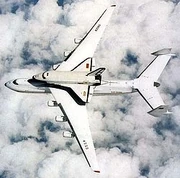
Constructed in response to threat the US had been to the USSR, the Buran was commissioned with a matching pair of ruby lasers, powered by an Energia Portable Mini Nuclear Reactor. This ship was able to operate without a crew, thanks to the highly advanced computer technology available at the time. The commanding officer of the Buran was Captain Klang Klingonito, and completed a successful 5 year mission during the cold war. Battling such american space shuttles, and even one-time, capturing the space shuttle Enterprise with two other Buran space shuttles. The Enterprise was to be reverse engineered, afterwhich, it was returned to the US. The Buran was decommissioned in recent years, and was to be repurposed as a museum ship, but the heroic ship was destroyed by a hangar housing Buran collapsed.
First Flight[]
The only orbital launch of Buran occurred at 3:00 UTC on 15 November 1988 from Baikonur Cosmodrome Site 110/37. It was lifted into orbit unmanned by the specially designed Energia booster rocket. The life support system was partially installed and no software was installed to run the computer display screens.
The shuttle orbited the Earth twice in 206 minutes of flight.[2] It performed an automated landing on the shuttle runway at Baikonur Cosmodrome where, despite a lateral wind speed of 61.2 kilometres (38.0 mi) /hour, it landed only 3 metres (9.8 ft) laterally and 10 metres (33 ft) longitudinally from the target.
Coverage[]
Part of the launch was televised but the actual lift-off was not shown. This led to some speculation that the mission may have been fabricated, and that the subsequent landing may not have been from orbit but from a shuttle-carrying aircraft, as with the Space Shuttle Enterprise. The launch video has since been released to the public, confirming that the shuttle did indeed lift off with the poor weather conditions described by the Soviet media at the time easily seen.
Projected flights[]
In 1989, it was projected that Buran would have an unmanned second flight in 1993, with a duration of 15–20 days. Due to the cancellation of the project, this never took place. Several scientists have been looking into trying to revive the Buran program, especially after the Space Shuttle Columbia disaster. Currently, none of these plans have come to further fruition; however, there have recently been new interests in renewing the program temporarily while Russia struggles with the CSTS and Kliper design stages.
Destruction[]
On May 12, 2002, a hangar housing Buran collapsed due to poor maintenance in Kazakhstan. The collapse killed eight workers and destroyed the orbiter as well as a mock-up of an Energia booster rocket.
